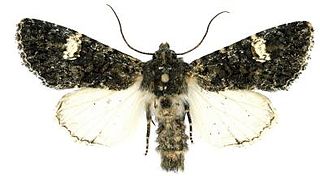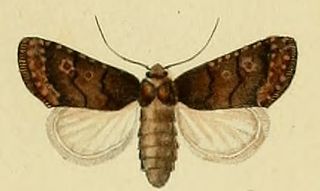
Grapholita funebrana, the plum fruit moth or red plum maggot, is a moth of the family Tortricidae. It is found in the Palearctic realm. Like many of its congeners, it is sometimes placed in Cydia.

Eucarta virgo, the silvery gem, is a moth of the family Noctuidae. The species first described by Georg Friedrich Treitschke in 1835. It can be found in south, southeast and central Europe.

Cerastis is a genus of moths of the family Noctuidae.

Cryphia is a genus of moths of the family Noctuidae. The genus was erected by Jacob Hübner in 1818.

Shargacucullia lychnitis, the striped lychnis is a moth of the family Noctuidae. It is found throughout most parts of Europe the Near East and Middle East.

Chazaria incarnata is a species of moth of the family Noctuidae. It is found on the Canary Islands and on the Iberian Peninsula, east to Italy, Serbia, Romania, Bulgaria, North Macedonia and Greece. Further east it is found to southern and eastern Russia in the north and Turkey, the Dead Sea region of Israel and Iran.

Apamea rubrirena is a moth of the family Noctuidae.

Abrepagoge is a monotypic genus of tortrix moths belonging to tribe Archipini of the subfamily Tortricinae. It was described in 1992 by Józef Razowski.

Archanara dissoluta, the brown-veined wainscot, is a moth of the family Noctuidae. The species was first described by Georg Friedrich Treitschke in 1825. It is found in most of Europe, east into Russia and Siberia.
Elachista purella is a moth of the family Elachistidae. It is found in Ukraine.
Hyperlais dulcinalis is a species of moth in the family Crambidae described by Georg Friedrich Treitschke in 1835. It is found in Italy, Croatia, Hungary, Romania, Bulgaria, the Republic of Macedonia, Greece, Turkey and Russia.

Loxostege turbidalis is a species of moth in the family Crambidae. It was described by Treitschke in 1829. It is found in most of Europe, except Ireland, Great Britain, Norway, the Benelux and the Iberian Peninsula. It has also been recorded from Russia, Turkey, China and Japan.

Polymixis serpentina is a moth of the family Noctuidae. It is found in Italy, the Balkan Peninsula and Crete.

Polymixis iatnana is a moth of the family Noctuidae. It is found on Cyprus.

Caradrina selini is a moth of the family Noctuidae. It was described by Jean Baptiste Boisduval in 1840. It is found in most of Europe, North Africa and the Near East.

Agrotis lata is a moth of the family Noctuidae. It was described by Georg Friedrich Treitschke in 1835. It is found in Algeria, Egypt, Libya, Morocco, Tunisia, Portugal and Spain, as well as on Sardinia, Sicily and Malta. It has also been recorded from Turkey and possibly Syria and Israel.
Anarta deserticola is a moth of the family Noctuidae. It was described by George Hampson in 1905. It is found along the coast of North Africa and on Malta.

Phiaris siderana is a moth of the family Tortricidae. It was described by Georg Friedrich Treitschke in 1835. It is found from Scandinavia south to Italy and Hungary and from France east to Russia.

Caradrina germainii is a moth of the family Noctuidae. It was described by Philogène Auguste Joseph Duponchel in 1835. It is found in south-western Europe and North Africa. It is found mostly in garigue habitats.

Grapholita gemmiferana is a species of moth of the family Tortricidae.

















